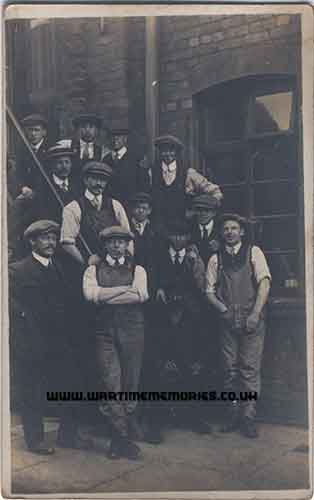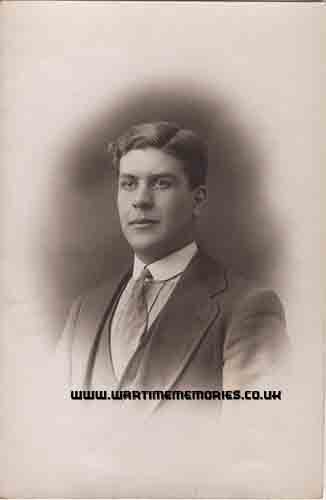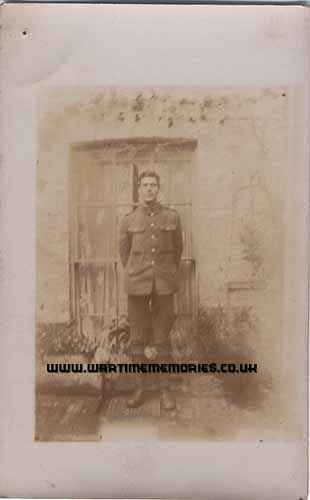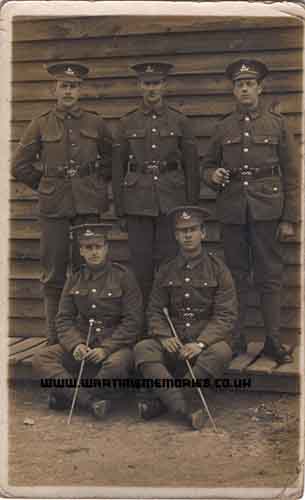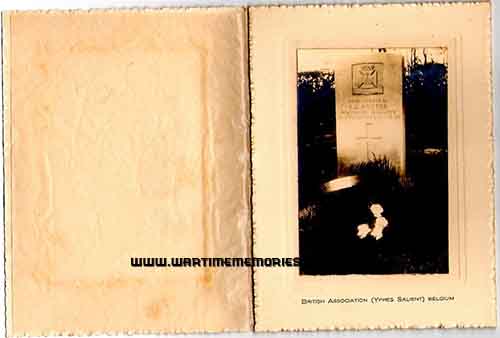Your message will be forwarded to the last contact details we have, your email address will not be passed on, they can reply to you via this messaging system.
Please scroll down to send a message.
Cpl. Sidney Dent Foster
British Army 1st Btn Wiltshire Regiment
from:Nuneaton, Warwickshire
(d.17th Feb 1917)
Sidney Dent Foster was born in 1896, in Nuneaton, Warwickshire, where his family had lived for several generations. His older brother, Percy, is my great-grandfather. My family are fortunate to have kept several artefacts, medals and papers from both brothers, which I now hold. It is from these, and some research, that I can share some of Sidney's story.
Sidney worked as a clerk for the gas board in Nuneaton. As well as Percy, he had a younger sister and 2 brothers. There is a formal studio shot of him taken just before the war in his Sunday best.
After his older brother enlisted as a volunteer at the start of the war Sidney, too, joined up. He initially joined the Royal Warwickshire Regiment, 13th Battalion, probably in October 1914. We have a picture (photo 3) of him standing in his first uniform, outside the house where he was billeted during training. One of the addresses kept by his brother shows that he was at a training camp near Blandford in Dorset. At some point Sidney seems to have transferred across to the 16th Battalion (3rd Birmingham Pals) and probably arrived in France with them in November, 1915. We have a picture of him as a Lance Corporal with some friends (photo 4), clearly showing the antelope cap badge of the Royal Warwickshires. From the state of their uniforms I assume this was taken before their arrival in France.
Whilst serving in France Sidney was transferred again, this time to the Wiltshire Regiment (Duke of Edinburgh's), 1st Battalion, C Company. This was a regular army unit in the 25th Division but we are not sure how or when this transfer took place.
At the start of 1917 the 1st Battalion of the Wiltshires was stationed in the line around Ploegsteert Wood, south of Ypres in Belgium. Here, between 12th - 14th February, Sidney's C Company was withdrawn from the rest of the battalion to prepare for a daylight trench raid. They rehearsed this attack many times while positioned at Pont de Nieppe, right on the French-Belgian border directly south of Ypres.
At 10:40 am on 17th February the raid commenced, following preparatory work to cut the wire defences in no-man's-land. C Company was joined by soldiers from 10th Battalion, Cheshire Regiment, totalling about 200 in the raiding party. The objectives were north and south of Factory Farm, as well as the farm itself, the primary aim being to surprise the enemy and retrieve prisoners and information.
The raid was successful in surprising the enemy, approximately 20 being killed by the preliminary bombardment or during the fighting. All objectives were taken, with the exception of Factory Farm where, in the words of the official war diary 'stout resistance was offered'. Other than the dead enemy, however, no German prisoners were captured and no useful identifications were made. This minor skirmish cost the raiding party (again, from the war diary) 4 other ranks killed, 26 wounded, 1 died of wounds and 1 missing. Most of this seems to have resulted from enemy machine gun fire as the party returned to the British lines. Cpl. Sidney Foster was one of those killed. He was 20 years old. The following day his battalion was withdrawn from the front line.
As well as official documents mentioning this incident, the family also received 3 letters that help to explain some of the circumstances surrounding Sidney's death. The first of these, dated 19th February, was from his platoon commander, Lt. G. K. Wait, who described the raid and some of the bombing that went on. He also mentions the enemy machine guns that fired on the returning group, a bullet hitting Sidney in the head.
The second letter was from one of Sid's best friends in 10 Platoon, Sgt. David Mansell, D.C.M. He wrote to Sid's parents to express his condolences and sense of loss at his friend's death. He briefly explains that Sidney was hit by shrapnel in the chest – not a bullet – and died almost instantly. (We will never know which story is most accurate. Many such letters describe a quick death when sent to the bereaved.)
The final letter, dated 28th February, is the Army form B. 104-82, officially notifying the family of the death. It is a very dry document, listing the titles and numbers identifying Sidney and noting the cause of death as Killed In Action.
By far the most significant document for the family, however, remains the hand-written final letter that Sidney wrote to his father during training for the raid, only 4 days before he was killed. He thanks everyone for the parcels that just arrived with gifts of cigarettes, food and so on. He sounds in good spirits and sends his love to all the family. Most of the remaining paperwork the family kept relates to Sidney's final resting place. An official grave card and picture was sent between the wars (photo 5), after the original crosses had been turned into headstones by the Commonwealth War Graves Commission. Sidney seems to be unusual in that he still lies in exactly the same place he was buried in 1917. He rests in a corner of the Berks Cemetery Extension, alongside his comrades from the Wiltshire and Cheshire regiments who fell on the same day.
Sidney's father, Frederick Foster, chose the inscription to be added to his gravestone, as a lasting tribute: 'At Rest, Ever Remembered By Loved Ones'. In some small way, telling this story is my own way of honouring those words.
